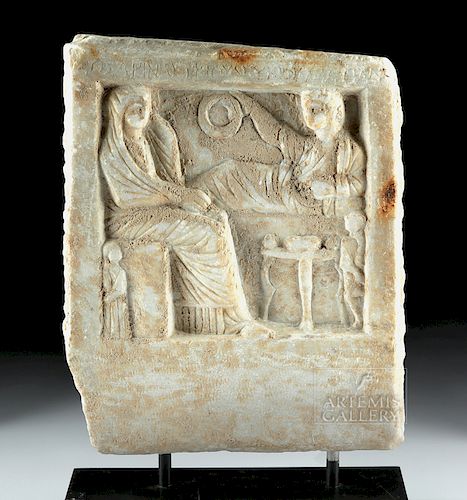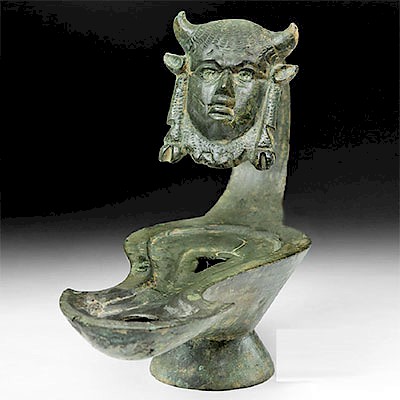Greco-Roman Marble Stele - Banquet Scene
Lot 31a
About Seller
Artemis Fine Arts
686 S Taylor Ave, Ste 106
Louisville, CO 80027
United States
Selling antiquities, ancient and ethnographic art online since 1993, Artemis Gallery specializes in Classical Antiquities (Egyptian, Greek, Roman, Near Eastern), Asian, Pre-Columbian, African / Tribal / Oceanographic art. Our extensive inventory includes pottery, stone, metal, wood, glass and textil...Read more
Estimate:
$5,000 - $7,000
Absentee vs Live bid
Two ways to bid:
- Leave a max absentee bid and the platform will bid on your behalf up to your maximum bid during the live auction.
- Bid live during the auction and your bids will be submitted real-time to the auctioneer.
Bid Increments
| Price | Bid Increment |
|---|---|
| $0 | $25 |
| $300 | $50 |
| $1,000 | $100 |
| $2,000 | $250 |
| $5,000 | $500 |
| $10,000 | $1,000 |
| $20,000 | $2,500 |
| $50,000 | $5,000 |
| $100,000 | $10,000 |
| $200,000 | $20,000 |
About Auction
By Artemis Fine Arts
Sep 27, 2018
Set Reminder
2018-09-27 10:00:00
2018-09-27 10:00:00
America/New_York
Bidsquare
Bidsquare : Antiquities | Asian | Ethnographic
https://www.bidsquare.com/auctions/artemis-gallery/antiquities-asian-ethnographic-3469
Featuring classical antiquities, ancient and ethnographic art from cultures encompassing the globe. Artemis Fine Arts info@artemisfinearts.com
Featuring classical antiquities, ancient and ethnographic art from cultures encompassing the globe. Artemis Fine Arts info@artemisfinearts.com
- Lot Description
Greco-Roman period, ca. 1st century BCE. A marble stele carved to mark a grave with two relief figures set into a border below a Greek inscription that likely states the name of the deceased but sadly is worn away on one end. The figures appear in a banqueting scene, with one reclining in the background, one hand raised and holding a round musical instrument - possibly a rhoptron, similar to a tambourine. The other figure is seated in the foreground, and appears to be a woman, draped in a himation that covers her hair. At her feet is a tiny figure that looks up at her - perhaps meant to be a child. Another tiny figure is crouched by a table on the other side of the relief, as if looking up at the reclining man. The round table holds what appears to be a variety of foods and stands on three thin legs that end in lion's paw-like feet. The two larger figures appear to be deep in conversation. Size: 10.95" W x 13.8" H (27.8 cm x 35.1 cm); 16.45" H (41.8 cm) on included custom stand.
A carved relief stele such as this one was part of a long tradition of marking the graves of elite and even some middle class Greek citizens. This item would have once been brightly painted, and the inscription along its top likely says the name of the deceased and perhaps the name of who dedicated this stele or the name of the dead person's home town. The form of the stele is meant to imitate a naiskos, a small temple/altar, and it likely once had a triangular pediment.
Provenance: ex-collection of Nicholas Kronwall, Arizona, USA; ex-Angelo R. Bergamo collection, New Jersey, USA; ex-Ariadne Gallery, New York, USA, inv. # 994., with label affixed to base; ex-Arte Primitivo, auct. 19, lot # 302
All items legal to buy/sell under U.S. Statute covering cultural patrimony Code 2600, CHAPTER 14, and are guaranteed to be as described or your money back.
A Certificate of Authenticity will accompany all winning bids.
We ship worldwide and handle all shipping in-house for your convenience.
#136828Upper portion and one lower corner are lost. Scratching and encrustation on surface commensurate with age. Some wear to motifs and the letters are not completely legible. Small iron patina stain on one side.Condition
- Shipping Info
-
All shipping is handled in-house for your convenience. Your invoice from Artemis Gallery will include shipping calculation instructions. If in doubt, please inquire BEFORE bidding for estimated shipping costs for individual items.
-
- Buyer's Premium



 EUR
EUR CAD
CAD AUD
AUD GBP
GBP MXN
MXN HKD
HKD CNY
CNY MYR
MYR SEK
SEK SGD
SGD CHF
CHF THB
THB














